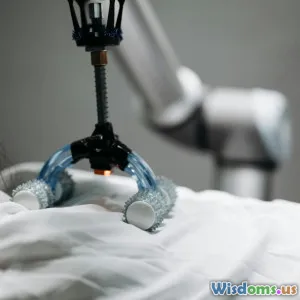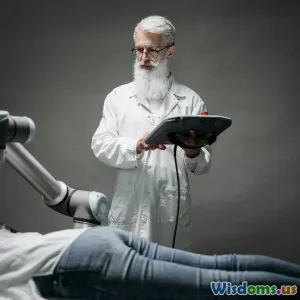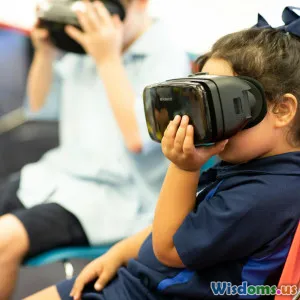
Can Robotic AI Replace Human Decision Making at Work
9 min read Explore whether robotic AI can fully replace human decision-making at work and uncover essential insights about the future of workplace intelligence. (0 Reviews)
Can Robotic AI Replace Human Decision Making at Work?
Introduction
Imagine walking into your office and discovering that major decisions—from strategic planning to conflict resolution—are now being handled by an artificial intelligence (AI) system rather than humans. This might sound like science fiction, yet advances in robotic AI are rapidly transforming workplaces worldwide. As machines become increasingly capable of mimicking human cognitive tasks, a pivotal question emerges: Can robotic AI truly replace human decision making at work?
In this in-depth exploration, we’ll uncover the potentials, constraints, and real-world impacts of AI-driven decision-making technologies, while also addressing ethical considerations and future implications. Whether you’re a business leader, a tech enthusiast, or simply curious about the future of work, this article offers valuable insights.
Understanding AI and Human Decision-Making
What is Robotic AI?
Robotic AI refers to automated systems, often embodied as robots or software agents, that not only execute tasks but also learn, analyze data, and make decisions based on programmed algorithms and machine learning models. These systems can recognize patterns in vast data sets much faster than humans and can operate 24/7 without fatigue.
Human Decision-Making: A Complex Art
Human decision-making involves rational analysis, emotional judgment, ethical evaluations, intuition, and sometimes even creativity—elements deeply rooted in experience and empathy. Decisions at work often incorporate social dynamics, value-driven considerations, and ambiguity management, none of which are straightforward for an AI to replicate.
The Current Capabilities of Robotic AI in Decision Making
Data-Driven Decisions
One of the greatest strengths of robotic AI lies in processing massive amounts of data. For instance, in financial services, robo-advisors analyze market trends, predict investment risks, and make portfolio choices with minimal human input. A 2023 report by McKinsey highlighted that AI has improved investment decision-making speed by 50% in some firms.
Automating Routine Decisions
Companies increasingly use AI to automate routine administrative decisions such as scheduling, employee leave approvals, or inventory management. Amazon’s warehouse robots optimize stocking and reordering decisions, significantly reducing human error and enhancing efficiency.
Enhancing Decision Support
Rather than fully replacing human decisions, many AI systems currently serve as decision-support tools. IBM’s Watson, for instance, helps doctors by analyzing millions of medical records to suggest treatment options, but final decisions still rest with human healthcare professionals.
Limitations of Robotic AI Compared to Humans
Lack of Emotional Intelligence and Empathy
Emotions and empathy greatly influence sensitive workplace decisions like conflict resolution, team morale, and leadership. Although there are developments in affective computing that enable AI to recognize emotions, such as sentiment analysis in emails, AI cannot genuinely feel empathy or understand nuanced human feelings.
Ethical and Moral Judgments
Many workplace decisions require weighing competing values or addressing ethical dilemmas. AI operates on programmed rules and learned patterns but cannot reason on subjective morality or cultural context with the finesse humans employ. For example, an AI might optimize for efficiency but overlook the human cost of layoffs.
Handling Ambiguity and Unpredictability
Robotic AI struggles when facing ambiguous situations or unprecedented problems. Humans excel at using intuition and experience to navigate uncertainty—a key aspect of strategic leadership and creativity.
Bias and Transparency Challenges
AI systems learn from historical data and can inherit or amplify biases present in training datasets. Amazon’s 2018 recruitment AI tool was scrapped after it showed gender bias. Additionally, AI’s 'black-box' decision making poses transparency challenges, complicating accountability.
Real-World Insights and Case Studies
Manufacturing: Collaborative Robotics in Decision Augmentation
At factories like General Motors, robotic systems collaborate with workers by analyzing production data in real-time to recommend process improvements. Here, AI augments human decisions, increasing precision without replacing human judgment.
Legal Industry: AI for Document Review—but Not Litigation Strategy
Legal tech companies use AI to scan thousands of contracts quickly to flag issues. However, the strategic decisions in litigation, settlement negotiations, and ethical considerations remain overwhelmingly human-driven due to complex legal frameworks and the need for emotional intelligence.
Retail: AI-Driven Inventory Decisions Balanced by Managerial Oversight
Retail giants such as Walmart use AI to forecast product demand and optimize supply chains. But store managers incorporate local insights and customer nuances when making promotions or layout changes—areas where AI lacks context sensitivity.
Ethical and Social Implications
Job Displacement and Workforce Evolution
Replacing human decision-making could jeopardize jobs, especially middle-management roles. Conversely, it can also shift workers toward higher-value tasks like strategic thinking and interpersonal roles. A 2022 World Economic Forum report estimated that AI might displace 85 million jobs but create 97 million new ones by 2025.
Accountability and Trust
If AI makes critical decisions that harm employees or customers, assigning accountability is complex. Building transparent, explainable AI systems is essential to maintain trust and comply with regulations.
Human Autonomy and Dignity
Overreliance on AI may erode human decision-making skills or reduce personal agency, impacting workplace satisfaction and ethical autonomy. Maintaining human oversight is vital.
The Future: Integration or Replacement?
Current trends suggest a future where AI supplements rather than supplants human discretion. Hybrid decision-making models leverage AI’s speed and data capacity alongside human judgment’s empathy and ethical nuance.
For example, leadership training increasingly incorporates AI tools for scenario simulations but continues to emphasize human values and critical thinking. Workplace AI will likely evolve to be a powerful assistant that empowers, rather than replaces, human decision-makers.
Conclusion
Robotic AI is undeniably revolutionizing aspects of workplace decision-making by accelerating data processing, automating routine choices, and enabling smarter strategies. However, full replacement of human judgment is neither feasible nor advisable today—given AI's limitations in emotional intelligence, ethical reasoning, and handling ambiguity.
The real opportunity lies in synergizing human and robotic intelligence: pairing data-driven machine analysis with the uniquely human capacity for empathy, creativity, and moral discernment. Leaders who harness this hybrid model can enhance productivity, innovation, and employee satisfaction.
Ultimately, while robotic AI will shape the future of decision-making at work, the human touch remains indispensable to create workplaces that value wisdom as much as speed.
By embracing robotic AI as a collaborative tool and preserving human decision-making strengths, organizations can navigate the complexities of the modern workplace with confidence and foresight.
Rate the Post
User Reviews
Popular Posts




















